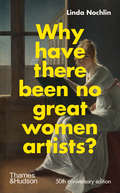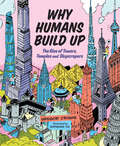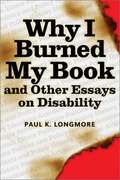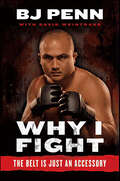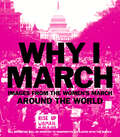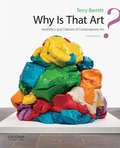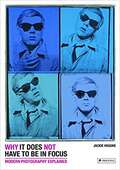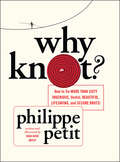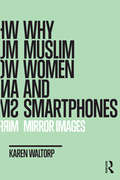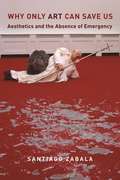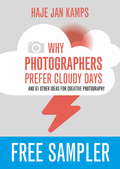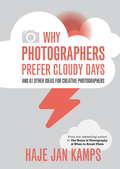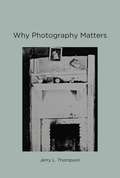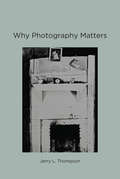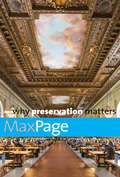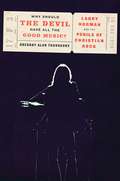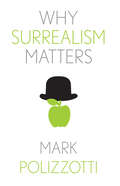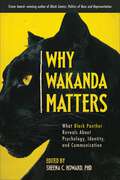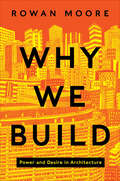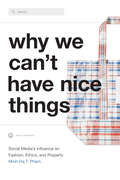- Table View
- List View
Why Have There Been No Great Women Artists?: 50th anniversary edition
by Linda NochlinThe fiftieth anniversary edition of the essay that is now recognized as the first major work of feminist art theory—published together with author Linda Nochlin’s reflections three decades later. Many scholars have called Linda Nochlin’s seminal essay on women artists the first real attempt at a feminist history of art. In her revolutionary essay, Nochlin refused to answer the question of why there had been no “great women artists” on its own corrupted terms, and instead, she dismantled the very concept of greatness, unraveling the basic assumptions that created the male-centric genius in art. With unparalleled insight and wit, Nochlin questioned the acceptance of a white male viewpoint in art history. And future freedom, as she saw it, requires women to leap into the unknown and risk demolishing the art world’s institutions in order to rebuild them anew. In this stand-alone anniversary edition, Nochlin’s essay is published alongside its reappraisal, “Thirty Years After.” Written in an era of thriving feminist theory, as well as queer theory, race, and postcolonial studies, “Thirty Years After” is a striking reflection on the emergence of a whole new canon. With reference to Joan Mitchell, Louise Bourgeois, Cindy Sherman, and many more, Nochlin diagnoses the state of women and art with unmatched precision and verve. “Why Have There Been No Great Women Artists?” has become a slogan and rallying cry that resonates across culture and society. In the 2020s, Nochlin’s message could not be more urgent: as she put it in 2015, “There is still a long way to go.”
Why Humans Build Up: The Rise of Towers, Temples and Skyscrapers (Orca Timeline #1)
by Gregor Craigie★“This great STEAM offering has multiple applications and will be useful for report writers and aspiring architects alike.”—Booklist, starred review ★“Finely detailed inside and outside...Broad in scope, perceptively organized, and enriched with fascinating entries.”—Kirkus Reviews, starred review Why did they build it so high? People have been constructing tall buildings for thousands of years, for many different reasons. Castle walls kept people safe. Utility towers transmit TV and cell-phone signals. Observatories give people a bird’s-eye view of the world. Beautiful buildings stand out in the crowd. Skyscrapers provide housing for a lot of people. There are some good reasons for building up, and a few bad ones as well. With a growing global population, we will need more and more space to live, learn and work in. But what does that mean for the health of the planet? Can we do it sustainably? Tall buildings may be part of the answer. From the Great Pyramids of Giza and the Leaning Tower of Pisa to the Burj Khalifa and the Shanghai Tower, Why Humans Build Up asks why and how we build higher and higher, and what that means for the planet.
Why I Burned My Book And Other Essays On Disability
by Paul K. Longmore<P>This wide-ranging book shows why Paul Longmore is one of the most respected figures in disability studies today. Understanding disability as a major variety of human experience, he urges us to establish it as a category of social, political, and historical analysis in much the same way that race, gender, and class already have been. The essays here search for the often hidden pattern of systemic prejudice and probe into the institutionalized discrimination that affects the one in five Americans with disabilities. <P>Whether writing about the social critic Randolph Bourne, contemporary political activists, or media representations of people with disabilities, Longmore demonstrates that the search for heroes is a key part of the continuing struggle of disabled people to gain a voice and to shape their destinies. His essays on bioethics and public policy examine the conflict of agendas between disability rights activists and non-disabled policy makers, healthcare professionals, euthanasia advocates, and corporate medical bureaucracies. <P> The title essay, which concludes the book, demonstrates the necessity of activism for any disabled person who wants access to the American dream. <P> Author note: Paul K. Longmore is Professor of History at San Francisco State University. He is the author of The Invention of George Washington and the co-editor (with Lauri Umansky) of The New Disability History: American Perspectives.
Why I Fight: The Belt Is Just an Accessory
by Dave Weintraub B.J. PennClaiming that “the belt is just an accessory,” Ultimate Fighting Championship (UFC) Lightweight Champion B.J. Penn explains Why I Fight in this honest, intimate, and fascinating memoir. Written with David Weintraub, Why I Fight is an unforgettable portrait of one of the top and most recognizable mixed martial artists in the UFC and an up-close look at one of the most exciting and fastest growing sports in the world. UFC and Jiu-Jitsu aficionados—and fans of Iceman, A Fighter’s Heart, and Bruce Lee’s classic The Tao of Jeet Kun Do—will want to explore Why I Fight.
Why I March: Images from The Women's March Around the World
by Abrams BooksAn inspiring photographic account of the worldwide Women’s March of 2017—one of the biggest peaceful protests in history.On January 21, 2017, five million people in eighty-two countries and on all seven continents stood up with one voice. The Women’s March began with one cause, women’s rights, but quickly became a movement around the many issues that were hotly debated during the 2016 U.S. presidential race—immigration, health care, environmental protections, LGBTQ rights, racial justice, freedom of religion, and workers’ rights, among others. In the mere sixty-six days between the election and inauguration of Donald J. Trump as the 45th President of the United States, 673 sister marches sprang up across the country and the world. Why I March documents and honors the movement, gives back to it—and inspires future activism in the same vein.All royalties from the sale of this book will be donated to nonprofit organizations affiliated with the March.
Why Is Daddy in a Dress?: Asking Awkward Questions with Baby Animals
by Ben Schwartz Amanda McCallWhy face the embarrassment of dealing with life's most awkward questions when adorable baby animals can do it for you? Amanda McCall and Ben Schwartz, the creators of the wickedly lovable Grandma's Dead, return with Why is Daddy in a Dress?, another invaluable aid to avoiding sticky situations. A book of postcards featuring cuddly kittens, playful puppies, fuzzy ducklings, and hoppity baby bunnies broaching sensitive subjects like "Are you a hooker?" or "Can we stop cuddling?," Why is Daddy in a Dress? is the perfect cure for foot-in-mouth disease.
Why Is That Art: Aesthetics and Criticism of Contemporary Art
by Terry BarrettIt introduces students to theories of art through the presentation of contemporary works that include abstract and representational painting, animated film, monumental sculpture,performance art, photographs, relational art, and video installations.
Why It Does Not Have To Be In Focus: Modern Photography Explained
by Jackie HigginsThis lively, informed defense of modern photography focuses on not focusing--and other unconventional methods that have been successfully employed by acclaimed photographers. <p><p> In an age where anyone with a camera can call him- or herself a photographer, an apparent lack of technique might be mistaken for a lack of artistic sophistication. In this delightful follow-up to Why Your Five-Year-Old Could Not Have Done That, Jackie Higgins offers superb examples to counter that assumption, such as Hiroshi Sugimoto's anachronistic use of a 19th-century large-format camera to produce intentionally fuzzy pictures, and Richard Prince's controversial technique of "re-photographing" photos, which unleashed a barrage of criticism that he was profiting from others' work. <p><p> From portraits to documentary images and from abstractions to landscapes, the author identifies 100 important images that are emblematic of innovation in modern photography, revealing the frequently complex processes involved in their composition. In so doing, she offers a provocative reminder of what makes a great photograph.
Why Knot?: How To Tie More Than Sixty Ingenious, Useful, Beautiful, Lifesaving, And Secure Knots!
by Philippe Petit“Mr. Petit is the perfect teacher” in this fascinating, educational volume on knot-tying—an art and science that has held civilization together (The Wall Street Journal). Philippe Petit is known for his astounding feat of daring when, on August 7, 1974, he stepped out on a wire illegally rigged between the World Trade Center’s twin towers in New York City. But beyond his balance, courage, and showmanship, there was one thing Petit had to be absolutely certain of—his knots. Without the confidence that his knots would hold, he never would have left the ground. In fact, while most of us don’t think about them beyond tying our shoelaces, the humble knot is crucial in countless contexts, from sailing to sports to industrial safety to art, agriculture, and more. In this truly unique book, Petit offers a guide to tying over sixty of his essential knots, with practical sketches illustrating his methods and clear tying instructions. Filled with photos in which special knots were used during spectacular high-wire walks, quirky knot trivia, personal anecdotes, helpful tips, magic tricks, and special tying challenges, Why Knot? will entertain and educate readers of all ages. “In reading Philippe’s book we are cogently reminded that without the ability to secure a rope, or tether a goat, or make fast the sheets of a galley, much of the civilization that we take for granted would disappear as easily as a slipknot in the hands of a Vegas conjuror.” —Sting, musician and activist “His descriptions are clear, he deploys humor frequently and he makes his points with anecdotes that are colorful and memorable. Explaining the purpose and creation of knots and thanks to those flawless drawings Mr. Petit earns perfect marks.” —The Wall Street Journal
Why Living Things Need… Homes (Into Reading Texas, Read Aloud Module 9 #1)
by Daniel NunnNIMAC-sourced textbook
Why Muslim Women and Smartphones: Mirror Images (Criminal Practice Ser.)
by Karen WaltorpUsing an assemblage approach to study how Muslim women in Norrebro, Denmark use their phones, Karen Waltorp examines how social media complicates the divide between public and private in relation to a group of people who find this distinction of utmost significance. Building on years of ethnographic fieldwork, Waltorp's ethnography reflects the trust and creativity of her relationships with these women which in turn open up nuanced discussions about both the subject at hand and best practice in conducting anthropological research. Combining rich ethnography with theoretical contextualization, Waltorp's book alternates between ethnography and analysis to illuminate a thoroughly modern community, and reveals the capacity of image-making technology to function as an infrastructure for seeing, thinking and engaging in fieldwork as an anthropologists. Waltorp identifies a series of important issues around anthropological approaches to new media, contributing to new debates around the anthropology of automation, data and self-tracking.
Why Only Art Can Save Us: Aesthetics and the Absence of Emergency
by Santiago ZabalaThe state of emergency, according to thinkers such as Carl Schmidt, Walter Benjamin, and Giorgio Agamben, is at the heart of any theory of politics. But today the problem is not the crises that we do confront, which are often used by governments to legitimize themselves, but the ones that political realism stops us from recognizing as emergencies, from widespread surveillance to climate change to the systemic shocks of neoliberalism. We need a way of disrupting the existing order that can energize radical democratic action rather than reinforcing the status quo. In this provocative book, Santiago Zabala declares that in an age where the greatest emergency is the absence of emergency, only contemporary art’s capacity to alter reality can save us.Why Only Art Can Save Us advances a new aesthetics centered on the nature of the emergency that characterizes the twenty-first century. Zabala draws on Martin Heidegger’s distinction between works of art that rescue us from emergency and those that are rescuers into emergency. The former are a means of cultural politics, conservers of the status quo that conceal emergencies; the latter are disruptive events that thrust us into emergencies. Building on Arthur Danto, Jacques Rancière, and Gianni Vattimo, who made aesthetics more responsive to contemporary art, Zabala argues that works of art are not simply a means of elevating consumerism or contemplating beauty but are points of departure to change the world. Radical artists create works that disclose and demand active intervention in ongoing crises. Interpreting works of art that aim to propel us into absent emergencies, Zabala shows how art’s ability to create new realities is fundamental to the politics of radical democracy in the state of emergency that is the present.
Why Photographers Prefer Cloudy Days: Surprising And Inspiring Tips For Photographers
by Haje Jan Kamps**FREE SAMPLER** There's no one secret to taking beautiful photos, but good photographers build up a series of useful bits of know-how. They know that clouds, far from ruining a photo, give a great soft natural light for portraits. They know that unusual angles draw the eye, and that their feet are just as effective as a zoom lens.This book packs 62 of the most important creative ideas into one easy-to-read location, beautifully presented with example photos. None of these ideas need an expensive camera, fancy lens or a over-priced flash. The purpose of this book is to help you tell stories with your camera, whatever the camera.Whether you're photographing that perfect sunset or your morning coffee, Why Photographers Prefer Cloudy Days will show you how to capture it to best effect, whether you want it to look great on your Instagram, or amazing on your wall.
Why Photographers Prefer Cloudy Days: Surprising And Inspiring Tips For Photographers
by Haje Jan KampsThere's no one secret to taking beautiful photos. But good photographers do have a few tricks up theirsleeves... They know that clouds, far from ruining a photo, give a great soft natural light for portraits. They know that unusual angles draw the eye, and that their feet are just as effective as a zoom lens.This book packs 62 of the most important creative ideas into one place. Beautifully presented, easy-to-read and packed with example photos. None of these ideas need an expensive camera, fancy lens or a over-priced flash. The purpose of this book is to help you tell stories with your camera (or phone).Whatever you want to shoot, Why Photographers Prefer Cloudy Days is packed full of ideas to inspire you, and tips that will help you take better, more original photos.
Why Photographers Prefer Cloudy Days: and 61 Other Ideas for Creative Photography
by Haje Jan KampsThere's no one secret to taking beautiful photos. But good photographers do have a few tricks up theirsleeves... They know that clouds, far from ruining a photo, give a great soft natural light for portraits. They know that unusual angles draw the eye, and that their feet are just as effective as a zoom lens.This book packs 62 of the most important creative ideas into one place. Beautifully presented, easy-to-read and packed with example photos. None of these ideas need an expensive camera, fancy lens or a over-priced flash. The purpose of this book is to help you tell stories with your camera (or phone).Whatever you want to shoot, Why Photographers Prefer Cloudy Days is packed full of ideas to inspire you, and tips that will help you take better, more original photos.
Why Photography Matters
by Jerry L. ThompsonPhotography matters, writes Jerry Thompson, because of how it works -- not only as an artistic medium but also as a way of knowing. It matters because how we understand what photography is and how it works tell us something about how we understand anything. With these provocative observations, Thompson begins a wide-ranging and lucid meditation on why photography is unique among the picture-making arts. Thompson, a working photographer for forty years, constructs an argument that moves with natural logic from Thomas Pynchon (and why we read him for his vision and not his command of miscellaneous facts) to Jonathan Swift to Plato to Emily Dickinson (who wrote "Tell all the Truth but tell it slant") to detailed readings of photographs by Eugene Atget, Garry Winogrand, Marcia Due, Walker Evans, and Robert Frank. He questions Susan Sontags assertion in "On Photography" that "nobody" can any longer imagine literate, authoritative, or transcendent photographs. He considers the money-fueled expansion of the market for photography, and he compares ambitious "meant-for-the-wall" photographs with smaller, quieter works. Forcefully and persuasively, Thompson argues for photography as a medium concerned with understanding the world we live in -- a medium whose business is not constructing fantasies pleasing to the eye or imagination but describing the world in the toughest and deepest way.
Why Photography Matters
by Jerry L. ThompsonA lucid and wide-ranging meditation on why photography is unique among the picture-making arts.Photography matters, writes Jerry Thompson, because of how it works—not only as an artistic medium but also as a way of knowing. With this provocative observation, Thompson begins a wide-ranging and lucid meditation on why photography is unique among the picture-making arts. He constructs an argument that moves with natural logic from Thomas Pynchon (and why we read him for his vision and not his command of miscellaneous facts) to Jonathan Swift to Plato to Emily Dickinson (who wrote “Tell all the Truth but tell it slant”) to detailed readings of photographs by Eugène Atget, Garry Winogrand, Marcia Due, Walker Evans, and Robert Frank. Forcefully and persuasively, he argues for photography as a medium whose business is not constructing fantasies pleasing to the eye or imagination, but describing the world in the toughest and deepest way.
Why Preservation Matters
by Max PageCommemorating the fiftieth anniversary of the National Historic Preservation Act, a critique of the preservation movement--and a bold vision for its future Every day, millions of people enter old buildings, pass monuments, and gaze at landscapes unaware that these acts are possible only thanks to the preservation movement. As we approach the October 2016 anniversary of the United States National Historic Preservation Act, historian Max Page offers a thoughtful assessment of the movement's past and charts a path toward a more progressive future. Page argues that if preservation is to play a central role in building more-just communities, it must transform itself to stand against gentrification, work more closely with the environmental sustainability movement, and challenge societies to confront their pasts. Touching on the history of the preservation movement in the United States and ranging the world, Page searches for inspiration on how to rejuvenate historic preservation for the next fifty years. This illuminating work will be widely read by urban planners, historians, and anyone with a stake in the past.
Why Should the Devil Have All the Good Music?: Larry Norman and the Perils of Christian Rock
by Gregory ThornburyThe riveting, untold story of the “Father of Christian Rock” and the conflicts that launched a billion-dollar industry at the dawn of America’s culture wars. In 1969, in Capitol Records' Hollywood studio, a blonde-haired troubadour named Larry Norman laid track for an album that would launch a new genre of music and one of the strangest, most interesting careers in modern rock. Having spent the bulk of the 1960s playing on bills with acts like the Who, Janis Joplin, and the Doors, Norman decided that he wanted to sing about the most countercultural subject of all: Jesus. Billboard called Norman “the most important songwriter since Paul Simon,” and his music would go on to inspire members of bands as diverse as U2, The Pixies, Guns ‘N Roses, and more. To a young generation of Christians who wanted a way to be different in the American cultural scene, Larry was a godsend—spinning songs about one’s eternal soul as deftly as he did ones critiquing consumerism, middle-class values, and the Vietnam War. To the religious establishment, however, he was a thorn in the side; and to secular music fans, he was an enigma, constantly offering up Jesus to problems they didn’t think were problems. Paul McCartney himself once told Larry, “You could be famous if you’d just drop the God stuff,” a statement that would foreshadow Norman’s ultimate demise. In Why Should the Devil Have all the Good Music?, Gregory Alan Thornbury draws on unparalleled access to Norman’s personal papers and archives to narrate the conflicts that defined the singer’s life, as he crisscrossed the developing fault lines between Evangelicals and mainstream American culture—friction that continues to this day. What emerges is a twisting, engrossing story about ambition, art, friendship, betrayal, and the turns one’s life can take when you believe God is on your side.
Why Surrealism Matters (Why X Matters Series)
by Mark PolizzottiAn elegant consideration of the Surrealist movement as a global phenomenon and why it continues to resonate Why does Surrealism continue to fascinate us a century after André Breton’s Manifesto of Surrealism? How do we encounter Surrealism today? Mark Polizzotti vibrantly reframes the Surrealist movement in contemporary terms and offers insight into why it continues to inspire makers and consumers of art, literature, and culture. Polizzotti shows how many forms of popular media can thank Surrealism for their existence, including Monty Python, Theatre of the Absurd, and trends in fashion, film, and literature. While discussing the movement’s iconic figures—including André Breton, Leonora Carrington, Salvador Dalí, René Magritte, Man Ray, and Dorothea Tanning—he also broadens the traditionally French and male-focused narrative, constructing a more diverse and global representation. And he addresses how the Surrealists grappled with ideas that mirror current concerns, including racial and economic injustice, sexual politics, issues of identity, labor unrest, and political activism. Why Surrealism Matters provides a concise, engaging exploration of how, a century later, the “Surrealist revolution” remains as dynamic as ever.
Why Theatre Matters
by Kathleen GallagherWhat makes young people care about themselves, others, their communities, and their futures? In Why Theatre Matters, Kathleen Gallagher uses the drama classroom as a window into the daily challenges of marginalized youth in Toronto, Boston, Taipei, and Lucknow. An ethnographic study which mixes quantitative and qualitative methodology in an international multi-site project, Why Theatre Matters ties together the issues of urban and arts education through the lens of student engagement. Gallagher's research presents a framework for understanding student involvement at school in the context of students' families and communities, as well as changing social, political, and economic realities around the world.Taking the reader into the classroom through the voices of the students themselves, Gallagher illustrates how creative expression through theatre can act as a rehearsal space for real, material struggles and for democratic participation. Why Theatre Matters is an invigorating challenge to the myths that surround urban youth and an impressive study of theatre's transformative potential.
Why Unicorn Drinks
by C. W. MossUnicorns are just like us. They have problems, stresses, and like to blow off some steam. Author and illustrator C. W. Moss explores the inner psyche of the single-horned in Why Unicorn Drinks.A follow-up to Unicorn Being a Jerk, this volume of 67 four-color illustrations and captions gives readers a glimpse into the sad reality of life as a mythical creature, and reveals what drives Unicorn to the bottle.As fans of Moss' online comic undoubtedly know, Why Unicorn Drinks pours a double-shot of laughter and irreverence. You'll never look at a unicorn the same way again.
Why Wakanda Matters: What Black Panther Reveals About Psychology, Identity, and Communication
by Sheena C. HowardIn 2018, the Marvel Cinematic Universe finally delivered on something fans had long been waiting for: a feature film with a solo Black superhero. Black Panther introduced viewers to the stunning world of Wakanda, a fictional African country with incredible technological advancements, and to T'Challa, a young man stepping into his role as king and taking up the mantle of the Black Panther title from his late father. The unforgettable story, coupled with the film's mega-success, has undoubtedly shaped the future of superhero cinema, in addition to genuinely changing viewers' lives. Why Wakanda Matters gives this iconic film the in-depth analysis it deserves under the lens of the latest psychological concepts-as well as delving into the lasting cultural impact of this unforgettable story. Edited by Sheena C. Howard, an award-winning author, filmmaker, and scholar, Why Wakanda Matters: What Black Panther Reveals About Psychology, Identity, and Communication features a collection of essays from leading experts in a variety of fields who offer insightful perspectives on topics such as: Cognitive dissonance: The important messages within T'Challa's nuanced identity and eventual shift from nationalism to globalism. Intergenerational trauma and resistance: How N'Jadaka (aka Erik/Killmonger) identifies with the trauma that his ancestors have suffered. Social identity: How Nakia, Shuri, Okoye, and Ramonda—all empowered, intelligent, and assertive women of color—can make a lasting impression on women and girls. Collective identity: How Black Panther has created a shared fantasy for Black audience members—and why this is groundbreaking. Cultural and racial identity: What we can learn from Black Panther's portrayal of a culture virtually untouched by white supremacy. Fans of the movie and those interested in deeper discussions about the film will revel in this thought-provoking examination of all aspects of Black Panther and the power of psychology.
Why We Build: Power and Desire in Architecture
by Rowan MooreIn an era of brash, expensive, provocative new buildings, a prominent critic argues that emotions—such as hope, power, sex, and our changing relationship to the idea of home—are the most powerful force behind architecture, yesterday and (especially) today.We are living in the most dramatic period in architectural history in more than half a century: a time when cityscapes are being redrawn on a yearly basis, architects are testing the very idea of what a building is, and whole cities are being invented overnight in exotic locales or here in the United States.Now, in a bold and wide-ranging new work, Rowan Moore—former director of the Architecture Foundation, now the architecture critic for The Observer—explores the reasons behind these changes in our built environment, and how they in turn are changing the way we live in the world. Taking as his starting point dramatic examples such as the High Line in New York City and the outrageous island experiment of Dubai, Moore then reaches far and wide: back in time to explore the Covent Garden brothels of eighteenth-century London and the fetishistic minimalism of Adolf Loos; across the world to assess a software magnate’s grandiose mansion in Atlanta and Daniel Libeskind’s failed design for the World Trade Center site; and finally to the deeply naturalistic work of Lina Bo Bardi, whom he celebrates as the most underrated architect of the modern era.
Why We Can't Have Nice Things: Social Media’s Influence on Fashion, Ethics, and Property
by Minh-Ha T. PhamIn 2016, social media users in Thailand called out the Paris-based luxury fashion house Balenciaga for copying the popular Thai “rainbow bag,” using Balenciaga’s hashtags to circulate memes revealing the source of the bags’ design. In Why We Can’t Have Nice Things Minh-Ha T. Pham examines the way social media users monitor the fashion market for the appearance of knockoff fashion, design theft, and plagiarism. Tracing the history of fashion antipiracy efforts back to the 1930s, she foregrounds the work of policing that has been tacitly outsourced to social media. Despite the social media concern for ethical fashion and consumption and the good intentions behind design policing, Pham shows that it has ironically deepened forms of social and market inequality, as it relies on and reinforces racist and colonial norms and ideas about what constitutes copying and what counts as creativity. These struggles over ethical fashion and intellectual property, Pham demonstrates, constitute deeper struggles over the colonial legacies of cultural property in digital and global economies.
